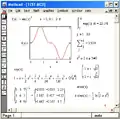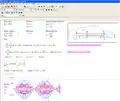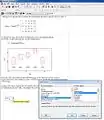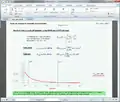Mathcad
Mathcad is computer software for the verification, validation, documentation and re-use of mathematical calculations in engineering and science, notably mechanical, chemical, electrical, and civil engineering.[3] Released in 1986 on DOS, it introduced live editing (WYSIWYG) of typeset mathematical notation in an interactive notebook, combined with automatic computations. It is a product of Parametric Technology Corporation.
 Mathcad Prime 1.0 | |
| Developer(s) | Mathsoft, PTC |
|---|---|
| Initial release | 1986 |
| Stable release | Prime 6.0[1]
/ October 1, 2019 |
| Operating system | Microsoft Windows |
| Available in | 10 languages[2] |
| Type | Computer algebra system |
| License | Proprietary |
| Website | www |
History
Mathcad was conceived and developed by Allen Razdow at his company Mathsoft. It was released in 1986. It was the first system to support WYSIWYG editing and recalculation of mathematical calculations mixed with text. It was also the first to check the consistency of engineering units through the full calculation. Other equation solving systems existed at the time, but did not provide a notebook interface: Software Arts' TK Solver was released in 1982, and Borland's Eureka: The Solver was released in 1987.[4]
Mathcad was acquired by Parametric Technology in April 2006.[5]
Overview
Mathcad's central interface is an interactive notebook in which equations and expressions are created and manipulated in the same graphical format in which they are presented (WYSIWYG). This approach was adopted by systems such as Mathematica, Maple, Macsyma, MATLAB, and Jupyter.
Mathcad today includes some of the capabilities of a computer algebra system, but remains oriented towards ease of use and documentation of numerical engineering applications.
Mathcad is part of a broader product development system developed by PTC, addressing analytical steps in systems engineering. It integrates with PTC's Creo Elements/Pro, Windchill, and Creo Elements/View. Its live feature-level integration with Creo Elements/Pro enables Mathcad analytical models to be directly used in driving CAD geometry, and its structural awareness within Windchill allows live calculations to be re-used and re-applied toward multiple design models.
Summary of capabilities
The Mathcad interface allows users to combine a variety of different elements (mathematics, descriptive text, and supporting imagery) into a worksheet, in which dependent calculations are dynamically recalculated as inputs change. This allows for simple manipulation of input variables, assumptions, and expressions. Mathcad's functionality includes:
- Numerous numeric functions for statistics, data analysis, image processing, and signal processing;
- Ubiquitous dimensionality checking and simplification;
- Solution of systems of equations, such as ODEs and PDEs using several methods;
- Root finding for polynomials and other functions;
- Symbolic manipulation of mathematical expressions;
- Parametric 2D and 3D plotting and discrete data plotting;
- Leverage standard, readable mathematical expressions within embedded program constructs;
- Vector and matrix operations, including eigenvalues and eigenvectors;
- Curve fitting and regression analysis;
- Statistical and Design of Experiments functions and plot types, and evaluation of probability distributions;
- Import from and export to other applications and file types, such as Microsoft Excel and MathML;[6]
- Cross references to other Mathcad worksheets;
- Integration with other engineering applications, such as CAD, FEM, BIM, and Simulation tools, to aid in product design, like Autocad, Ansys, Revit.
Although Mathcad is mostly oriented to non-programmers, it is also used in more complex projects to visualize results of mathematical modeling by using distributed computing and coupling with programs written using more traditional languages such as C++.
Current releases
As of 2020, the latest release from PTC is Mathcad Prime 6.0.0.0. This release is a freemium variant: if the software is not activated after a Mathcad Prime 30-day trial, it is possible to continue using PTC Mathcad Express for an unlimited time as "PTC Mathcad Express Free-for-Life Engineering Calculations Software". This freemium pilot is a new marketing approach for PTC. Review and markup of engineering notes can now be done directly by team members without them all requiring a full Mathcad Prime license.[7]
The last release of the traditional (pre "Prime") product line, Mathcad 15.0, came out in June 2010 and shares the same worksheet file structure as Mathcad 14.0. The last service release, Mathcad 15.0 M050, which added support for Windows 10, was released in 2017. Mathcad 15.0 is no longer actively developed but in "Sustained Support".
Computer operating system platforms
Mathcad only runs on Microsoft Windows. Mathcad Prime 6.0 requires a 64-bit version of Windows 7, Windows 8.1 or Windows 10. Until 1998, Mathcad also supported Mac OS.[8]
Support
After PTC's purchase of Mathcad in 2006,[9] changes were made to the Mathcad support policy. That change specified non-maintenance bearing licenses were no longer able to receive updates, including bug fixes, without purchasing a maintenance contract.[10] The price of a Mathcad maintenance contract for an individual is roughly half the cost of a single-user license upgrade at the time of a major Mathcad release, and grants the user the right to receive major releases in addition to bug fixes, access to engineering content, technical support, self-service license transferring tools, and more.
The Mathcad Business Unit within PTC recently updated its support policy. For Mathcad 15.0 and future versions of Mathcad, the first year of maintenance entitlements and support will be included in the purchase or upgrade price.
Release history
| Name | Version | Release Date | Notes |
|---|---|---|---|
| Mathcad 0.3 | 0.3 | beta on 5 1/4 floppy | |
| Mathcad 2.5.2 | 2.5.2 | Added document interface, last DOS version | |
| Mathcad 3.1 | 3.1 | Windows version | |
| Mathcad 4.0 | 4.0 | Windows version | |
| Mathcad 5.0 | 5.0 | Added Maple based CAS features | |
| Mathcad 5.5 | 5.5 | Windows version | |
| Mathcad 6.0[11] | 6.0 | 1995 | Last Windows 3.1 version |
| Mathcad 7[12] | 7.0 | 1997 | |
| Mathcad 8[13] | |||
| Mathcad 2000[14] | |||
| Mathcad 2001i[15] | |||
| Mathcad 11[16] | |||
| Mathcad 12[17] | |||
| Mathcad 13.0[18] | 13.0 | September 15, 2005[19] | |
| Mathcad 13.1[18] | 13.1 | ||
| Mathcad 14.0[18] | 14.0 | February 12, 2007[19] | |
| Mathcad 15.0[20] | 15.0 F000 | June 25, 2010[19] | |
| Mathcad 15.0 M010[20] | 15.0 M010 | June 29, 2011[19] | |
| Mathcad 15.0 M040[19] | 15.0 M040 | August 2015 | |
| Mathcad 15.0 M045[21] | November 2015[21] | ||
| Mathcad 15.0 M050[22] | 15.0 M050 | December 2017 | |
| Mathcad Prime 1.0[23] | January 10, 2011[19] | ||
| Mathcad Prime 2.0 | February 29, 2012[19] | ||
| Mathcad Prime 3.0 | October 2, 2013[19] | ||
| Mathcad Prime 3.1 | March 2, 2015[19] | ||
| Mathcad Prime 4.0 | March 6, 2017[19] | ||
| Mathcad Prime 5.0 | 5.0.0.0 | August 14, 2018[24] | |
| Mathcad Prime 6.0 | 6.0.0.0 | October 1, 2019[25][26] |
Screen captures of previous Mathcad versions
 Mathcad 2.52 (1989)
Mathcad 2.52 (1989) Mathcad 3.1 (1992)
Mathcad 3.1 (1992) Mathcad PLUS 6.0 (1995)
Mathcad PLUS 6.0 (1995) Mathcad 13.0
Mathcad 13.0 Mathcad 15.0
Mathcad 15.0 Mathcad Prime 1.0
Mathcad Prime 1.0 Mathcad Prime 1.0 working session
Mathcad Prime 1.0 working session
See also
- Comparison of computer algebra systems
- Comparison of numerical analysis software
- TK Solver
- PTC:Creo
- PTC:Windchill
- SMath Studio, a freeware similar to MathCad
References
- "What's New in PTC Mathcad Prime 6.0?". Mathcad. PTC. Retrieved 2020-11-07.
- "Mathcad Language Support - PTC.com". Retrieved 2020-11-07.
- "PTC Mathcad - PTC". Retrieved 2020-11-07.
- Ronald Shone, "Software for Solving Equations: Eureka: The Solver, TK Solver Plus and Mathcad", Journal of Economic Surveys 3:1:83–95 doi:10.1111/j.1467-6419.1989.tb00059.x (March 1989)
- PTC buys Mathsoft for $63m : April 2006 Archived 2007-09-28 at the Wayback Machine
- "Archived copy". Archived from the original on 2011-09-16. Retrieved 2011-09-09.CS1 maint: archived copy as title (link)
- ENGINEERING.com. "Psst... PTC is Giving Away Mathcad Express. Pass it on. > ENGINEERING.com". Archived from the original on 2013-10-12.
- "Archived copy". Archived from the original on 2009-06-11. Retrieved 2009-10-23.CS1 maint: archived copy as title (link)
- "PTC to Acquire Mathsoft Engineering & Education (April 26, 2006 slide show)" (PDF). corporate-ir.net. Archived from the original (PDF) on 3 March 2016. Retrieved 24 April 2018.
- "Global Maintenance Support - Packages - PTC.com". Archived from the original on 2008-05-13. Retrieved 2008-05-22.
- "Mathcad Features Comparison Chart". Archived from the original on 1996-11-10. Retrieved 2016-06-12.
- "Mathcad PLUS 6.0 and Mathcad 7 Professional Comparison". Archived from the original on 1998-02-20. Retrieved 2016-06-12.
- "Mathcad Features: Version by Version Comparison". Archived from the original on 2000-09-29. Retrieved 2016-06-12.
- "Mathcad Version Comparison Chart". Archived from the original on 1999-11-28. Retrieved 2016-06-12.
- "What's New in Mathcad 2001i". Archived from the original on 2001-02-15. Retrieved 2016-06-11.
- "What's New in Mathcad 11". Archived from the original on 2002-11-11. Retrieved 2016-06-11.
- "Untitled" (PDF). Archived from the original (PDF) on 2004-09-16. Retrieved 2016-06-12.
- "Release Notes for Mathcad 14". Archived from the original on 2017-05-10. Retrieved 2016-06-12.
- "When to release Mathcad 15 M040?". Archived from the original on 2016-06-16. Retrieved 2016-06-12.
- "Latest Release of MC15 (M0??)". Archived from the original on 2016-06-16. Retrieved 2016-06-12.
- "Mathcad 15 M045 release notes ("Read This First" guide)". Archived from the original on 2016-06-16. Retrieved 2016-06-12.
- "New service release of Mathcad 15 M050". community.ptc.com. 2017-12-15. Retrieved 2020-06-24.
- "Choose the Mathcad® product that's right for you" (PDF). Archived from the original (PDF) on 2011-08-10. Retrieved 2016-06-12.
- "PTC Mathcad Prime 5.0 Introduces New 2D Plotting Capabilities | PTC". Retrieved 2018-08-28.
- "PTC Mathcad Prime 6.0 Brings Engineering Calculations to Life". www.ptc.com. Retrieved 2019-11-01.
- "PTC Mathcad Prime 6.0 Introduces New 2D Plotting Capabilities | PTC". www.ptc.com. Retrieved 2019-11-01.
